Digi XBee® Mobile is an iOS and Android compatible app for connecting and configuring Digi XBee3 devices using their new onboard Bluetooth. The XBee Mobile App helps commission, provision, activate, investigate and update your XBee3 radio modules wirelessly, with no physical access required. Once Bluetooth is activated you can leave behind your heavy laptop, development board and USB cables. Going forward, your smartphone is all you’ll need to manage your Digi XBee3 radio module.
Using the XBee Mobile App
In this hands-on guide, we’ll show you how to:
- Look for and connect to nearby XBee3 BLE devices.
- Get basic information about the device and the firmware version it is running.
- List all the configuration categories and settings of the firmware running in the XBee3 device.
- Read and change the value of any firmware setting.
- Perform a remote reset of the device.
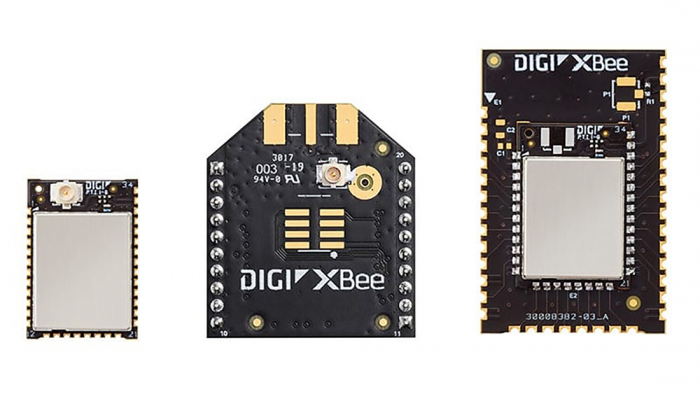
Digi XBee3 in micro, through-hole and SMT modules
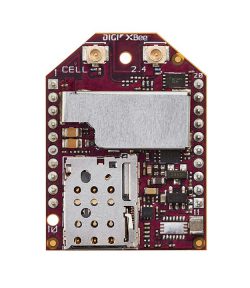 Digi XBee3 Cellular
Digi XBee3 Cellular
The XBee Mobile App works with:

The XBee Mobile application is a free download for both Android and iOS. Download it onto your tablet or smartphone and launch the app to continue. Be sure to review the
XBee Mobile App documentation. Once the app is installed with your XBee3 radio module powered on, you're ready to connect.
Connecting to XBee3
When you start the XBee Mobile app, it will search for all nearby Bluetooth-enabled XBee3 radio modules.
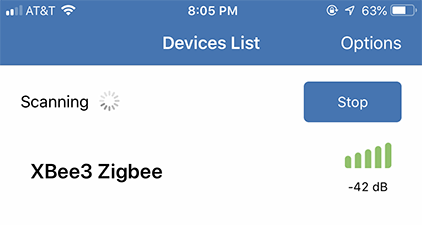 Searching for devices
Searching for devices
Tap on your XBee3 to select it. Enter the password you configured during the XCTU setup.
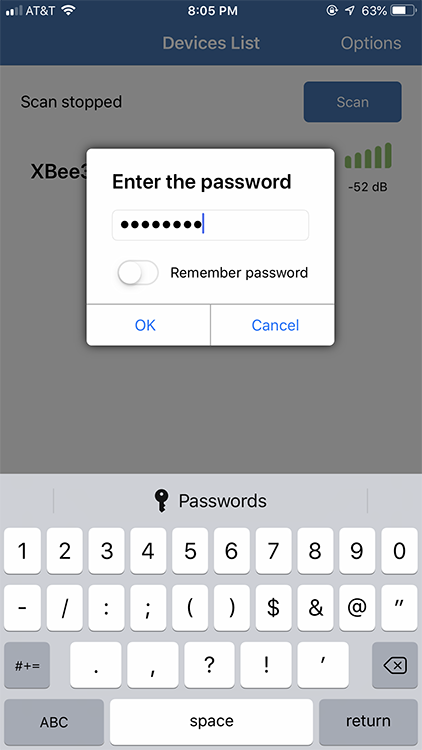 Password screen
Password screen
When you have entered the correct password, the XBee3 device configuration categories will be displayed.
Notice that the module is identified by only its MAC address; the
Name field is blank by default.
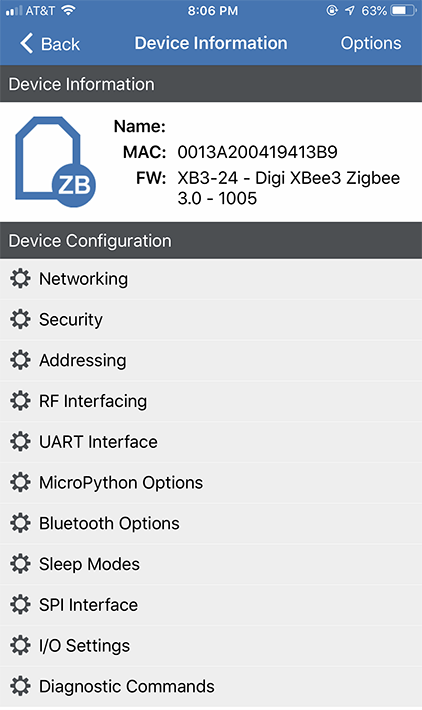 XBee device configuration
XBee device configuration
Using the XBee Mobile App
Entering a new setting is very easy. Let's give the XBee3 a real name, so we can label it in a human-friendly fashion. For example, in a municipal street lighting application, we might give it a label like "Streetlight 476". Tap the Addressing category to see the current setup. Scroll down to Node Identifier, which is blank by default. Tap on this field to enter new text, typing in "Streetlight 476". Tap the Write button once you are done.
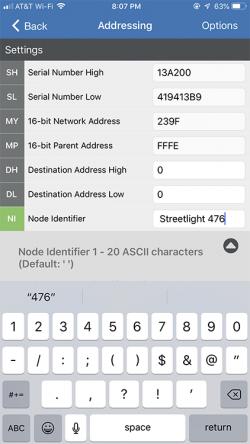 |
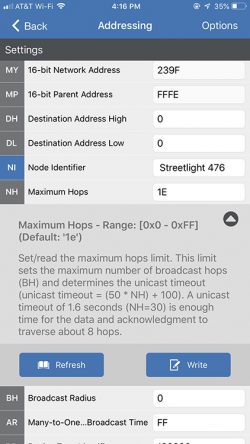 |
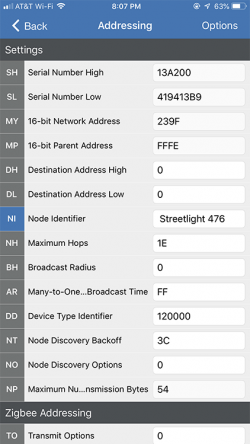 |
| Addressing settings, modifying Node Identifier |
Write the changed setting |
Node Identifier saved |
The information you entered in
Node Identifier was saved to the XBee3. It can be displayed in addition to the radio module's MAC address, making it easier to identify it wirelessly when many others are present. You will see this Node Identifier displayed inside the XBee Mobile application as "
Name: Streetlight 476".
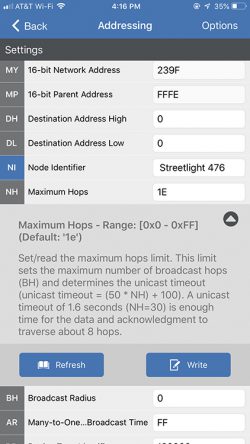 NH maximum hops help text
NH maximum hops help text
Tap
Options at the top right of the screen to display various read/write commands for this category, as well as some basic control functions. For now, just tap
Cancel and then tap
< Back at the top left of the screen to return to the
Device Information page. Tapping
Options here shows just the basic control functions. Tap
Disconnect to end your session.
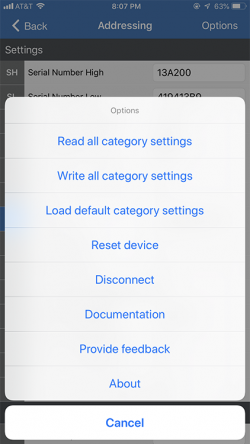 |
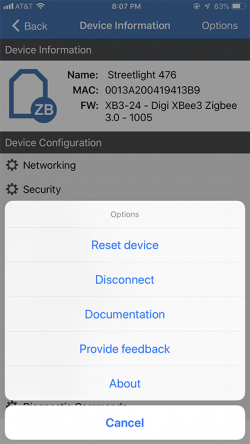 |
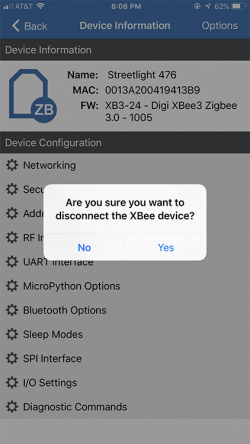 |
| Options for current category |
Options for whole device |
Confirm disconnection |
Useful Settings
There are a lot of settings to choose from. In many applications the factory defaults will be optimal. It's best to change only what you need to, though don't be afraid to experiment within your test environment. It's a great way to learn. Here are some you might want to look at first, since they are more frequently customized:
- During initial configuration and commissioning of the radio module you may want to set the serial baud rate (UART category, BD Baud Rate), configure GPIO input and output pins (I/O Settings category), change the local API mode (UART category, AP API Enable), request Zigbee coordinator verification during join (Networking category, JV Coordinator Verification) and enable network encryption (Security category).
- Sleeping the radio module will save energy, battery life and therefore also save money (Sleep Modes category). MicroPython scripts allow intelligent decision making to occur onboard the XBee3 module, if you launch them automatically (MicroPython Options, PS MicroPython Autostart). See our series of MicroPython posts for more information.
- In the field you can activate one Zigbee radio module to be a coordinator (Networking category, CE Device Role), request serial join verification notices (Networking, JV Join Verification) and see various diagnostic information, including the internal temperature (Diagnostic Commands, TP Temperature). And there's plenty more.
Summary
This tutorial guided you through using the Digi XBee Mobile App to connect with and configure a Digi XBee3 device over Bluetooth. You searched for and connected to an XBee3 radio module, viewed basic information, listed various configuration categories, changed several firmware settings and saw how to remotely reset the module.